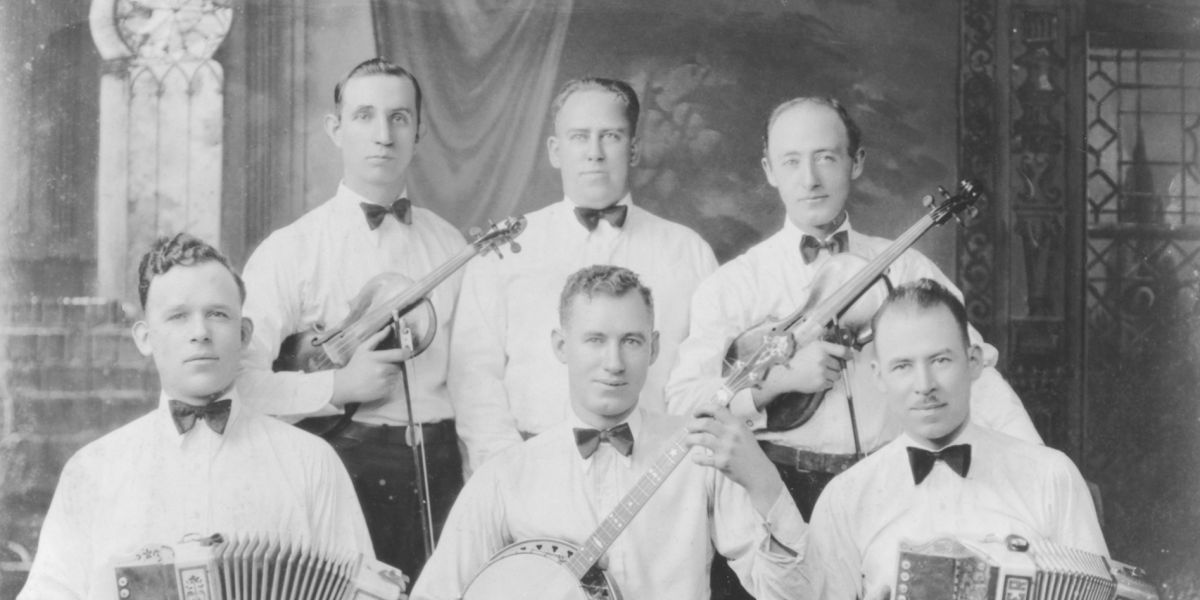
1893–1947

James Morrison was born on 3 May 1893 in Drumfin, a townland in the parish of Kilmorgan on the “tar road to Sligo” (now the N4) not far from the town of Riverstown, County Sligo. He was the second eldest of eleven children of Pat and Margaret (née Dolan) Morrison. His uncle Charlie Dolan was a dancing master whose home, a resort for local musicians and dancers, was where a young Jim Morrison took step dancing lessons and acquainted himself with the local music tradition. It was also where he first met his great contemporary, Michael Coleman, another dance student of Charlie Dolan.
Morrison’s first instrument was his brother Tom’s flute, but he was given a fiddle of his own at age thirteen. There was a wealth of talented local fiddle and flute players to learn from, including fiddler Tom Johnston from Drumfin Cross and the travelling piper Johnny Gorman, a frequent visitor.
Leaving school at fifteen, Morrison worked as a farm labourer and also as a dancing master, a fiddler for dances and an Irish language instructor for the Gaelic League. On one of his many visits to the Corhober home of fiddler John Joe Gardiner and his sister Kathleen, he met his future wife, Teresa Flynn. Morrison was an enthusiastic competitor at fiddle competitions. In a 1933 ad for his music teaching in New York, he would later boast that he was “the only musician in New York to win first prize at Sligo Feis Ceoil, a competition open to Ireland ; first prize at Connacht Feis, also a competition open to Ireland ; first prize at County Sligo Championship five years in succession ; first prize at County Mayo Championship and a prize at the recent New York Feis, open to all comers.” The ten shillings he won in the fiddle competition at the Sligo Feis Ceoil in 1915 helped fund his passage later that year to Boston, Massachusetts.
Boston was the destination because five of Jim’s siblings were already there. He lodged with his sister Margaret in Peabody, briefly worked at a shoe factory, and played in a dance band with his brothers Tom and John. When Teresa Flynn moved to New York in 1918, Morrison followed her there, rooming in Brooklyn with uilleann piper Michael Carney before marrying Teresa in April, 1919. They would have six children together but separated permanently in the mid-1930s.
Once in New York, Morrison immediately immersed himself in the lively Irish traditional music world of the city. He settled at 357 West 58th Street near Columbus Circle and introduced himself to the community by winning the fiddle competition at the 1919 New York feis. He formed his own small dance band and began making 78 rpm discs in 1921, eventually releasing over 80 sides as a soloist, in duets with pipers Michael Carney and Tom Ennis, melodeon player P.J. Conlon and flute player John McKenna, and as the leader of his own dance band. In 1925 he had his own shop, “Morrison’s Music House,” at 195 St. Nicholas Avenue in Harlem and for a few years staged an annual “Morrison Music Association” reception and dance.
The Great Depression that followed the 1929 Wall Street crash put an end to many musical careers, but Morrison soldiered on. He continued to perform weekly on radio and in dance halls. In December 1934 he took over the former Roscommon Ballroom at 438 W. 125th Street, got a liquor license, renamed it “Celtic Hall” and played with his own orchestra every Thursday, Saturday and Sunday. Unfortunately, the business did not prosper, and he had to relinquish control to partners who renamed the place the Ballina Ballroom in April of 1935. The following year he made his final commercial recordings with a quartet that included Kerry button accordionist Tom Carmody.
In his last years Morrison focused on teaching music. A 1933 notice for the “Morrison Music School” in the Mott Haven in the south Bronx advertised lessons for violin, piano, tenor banjo, mandolin, and accordion (“Now teaching 100 Pupils per Week / Your Expert Instructor / High Class Musical Instruments For Sale“). “Professor James Morrison” was chosen by the Globe melodeon company to author a tutor for that instrument.
Among Morrison’s prize students were fiddlers Joey Flynn, whom contemporaries regarded as virtuosic, and Jackie Roche, who was likely the second fiddler on some late Morrison duet sides and went on to a career as a recording artist and band leader in his own right. One of Morrison’s last surviving students, fiddler Veronica McNamara Gebert, related that Morrison would teach her one-on-one using a tenor banjo to play the melody. Late in life, Veronica collaborated with harpist Iris Nevins to issue a book of hand-written tunes (including bowings) given by Morrison to his students.
James Morrison died on 11 November 1947 and is interred, like many of his great musical contemporaries, in St. Raymond’s Cemetery in the Bronx.